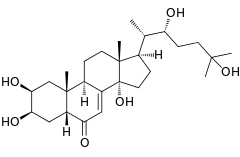Ecdysteroid

Chemical structure of the ecdysteroid ecdysone
Ecdysteroids are arthropod steroid hormones that are mainly responsible for molting, development and, to a lesser extent, reproduction;[1][2][3] examples of ecdysteroids include ecdysone, ecdysterone, turkesterone and 20-hydroxyecdysone.[4] These compounds are synthesized in arthropods from dietary cholesterol upon metabolism by the Halloween family of cytochrome P450s.[5] Phytoecdysteroids also appear in many plants mostly as a protection agents (toxins or antifeedants) against herbivore insects.[6][7]
See also
References
- ↑ de Loof A (2006). "Ecdysteroids: the overlooked sex steroids of insects? Males: the black box". Insect Science. 13 (5): 325–338. doi:10.1111/j.1744-7917.2006.00101.x.
- ↑ KRISHNAKUMARAN, A.; SCHNEIDERMAN, H. A. (December 1970). "CONTROL OF MOLTING IN MANDIBULATE AND CHELICERATE ARTHROPODS BY ECDYSONES". The Biological Bulletin. 139 (3): 520–538. doi:10.2307/1540371. ISSN 0006-3185.
- ↑ "Ecdysteroid titers and developmental expression of ecdysteroid-regulated genes during metamorphosis of the yellow fever mosquito, Aedes aegypti (Diptera: Culicidae)". Journal of Insect Physiology. 52 (6): 558–568. 2006-06-01. doi:10.1016/j.jinsphys.2006.02.003. ISSN 0022-1910.
- ↑ "Ecdysteroids Information". Examine.com. Retrieved 27 May 2015.
- ↑ "Ecdysteroid metabolism in crustaceans". The Journal of Steroid Biochemistry and Molecular Biology. 127 (3–5): 196–203. 2011-11-01. doi:10.1016/j.jsbmb.2010.09.001. ISSN 0960-0760.
- ↑ Dinan L (2001). "Phytoecdysteroids: biological aspects". Phytochemistry. 57 (3): 325–339. doi:10.1016/S0031-9422(01)00078-4. PMID 11393511.
- ↑ Dinan L, Savchenko T, Whiting P (2001). "On the distribution of phytoecdysteroids in plants". Cellular and Molecular Life Sciences. 58 (8): 1121–1132. doi:10.1007/PL00000926. PMID 11529504.
This article is issued from
Wikipedia.
The text is licensed under Creative Commons - Attribution - Sharealike.
Additional terms may apply for the media files.